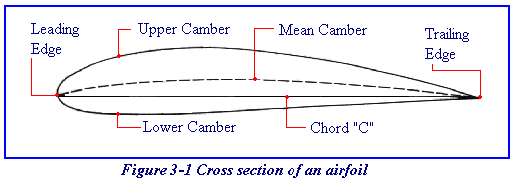 |
|||||
| Home | Research | For Teachers | HISTORY Level 1 Level 2 Level 3 |
PRINCIPLES Level 1 Level 2 Level 3 |
CAREER Level 1 Level 2 Level 3 |
| Gallery | Hot Links | What's New! | |||
| Web Administration and Tools | |||||
 |
|||||
| Home | Research | For Teachers | HISTORY Level 1 Level 2 Level 3 |
PRINCIPLES Level 1 Level 2 Level 3 |
CAREER Level 1 Level 2 Level 3 |
| Gallery | Hot Links | What's New! | |||
| Web Administration and Tools | |||||
Wing Design - Level 3
![]()
The type of operation for which an airplane is intended has a very
important bearing on the selection of the shape and design of the wing for that airplane.
If the airplane is designed for low speed, a thick airfoil is most efficient. A thin
airfoil is best for high speed.
CONVENTIONAL AIRFOILS and LAMINAR FLOW AIRFOILS , are in common use in airplane design.
Laminar flow airfoils were originally developed for the purpose of making an airplane fly faster. The laminar flow wing is usually thinner than the conventional airfoil, the leading edge is more pointed and its upper and lower surfaces are nearly symmetrical. The major and most important difference between the two types of airfoil is this, the thickest part of a laminar wing occurs at 50% chord while in the conventional design the thickest part is at 25% chord.
The effect achieved by this type of design of a wing is to maintain the laminar flow of air throughout a greater percentage of the chord of the wing and to control the transition point. Drag is therefore considerably reduced since the laminar airfoil takes less energy to slide through the air. The pressure distribution on the laminar flow wing is much more even since the camber of the wing from the leading edge to the point of maximum camber is more gradual than on the conventional airfoil. However, at the point of stall, the transition point moves more rapidly forward.
NACA AIRFOIL NUMBERING SYSTEM
Many times you will see airfoils described as NACA xxxx or NACA xxxxx or NACA xxy-xxx series. From the book Airplane Aerodynamics, by Dommasch, Sherby and Connally, Pitman Press, 1967, the following definitions are given to this nomenclature.

The NACA 4-digit airfoils mean the following: The first digit expresses
the camber in percent chord, the second digit gives the location of the maximum camber
point in tenths of chord, and the last two digits give the thickness in percent chord.
Thus 4412 has a maximum camber of 4% of chord located at 40% chord back from the leading
edge and is 12% thick, while 0006 is a symmetrical section of 6% thickness.
The NACA 5 digit series airfoil means the following: The first digit designates the
approximate camber in percent chord, the second digit indicates twice the position of the
maximum camber in tenths chord, the third (either 0 or 1) distinguishes the type of
mean-camber line, and the last two digits give the thickness in percent chord. Thus, the
23012 airfoil has a maximum camber of about 2% of the chord located at 15% of the chord
from the leading edge (3 tenths divided by 2) and is 12% thick.
The NACA six, seven and even eight series were designed to highlight some aerodynamic characteristic. For example, NACA 653-421 is a 6-series airfoil for which the minimum pressure's position in tenths chord is indicated by the second digit (here, at the 50% chord location), the subscript 3 means that the drag coefficient is near its minimum value over a range of lift coefficients of 0.3 above and below the design lift coefficient, the next digit indicates the lift coefficient in tenths (here, 0.4) and the last two digits give the maximum thickness in percent chord (here, 21% of chord). The description for this example comes from Foundations of Aerodynamics, Kuethe and Schetzer, 2nd Edition, 1959, John Wiley and Sons, New York.
There are formulas that define all the stations of the airfoil section from these digits and you can probably find those in your library in any good aerodynamics book. Also, you are referred to two other references listed below for more information on these classifications. HOWEVER, in all cases, the last two digits of the classification gives the thickness in percent chord.
Summary of Airfoil Data, NACA Report 824, 1945, by Abbott, von Doenhoff and Stivers. It was originally issued as ACR L5C05.
Theory of Wing Sections, Including a Summary of Airfoil Data, by Abbott and von Doenhoff, Mc-Graw Hill, New York, 1949, in which families of airfoils constructed according to a certain plan were tested and their characteristics recorded.
The information in this section has been extracted from several sources. Those sources have been contacted and permission to use their material on our site is pending. However, the format in which this material has been presented is copyrighted by the ALLSTAR network.
Send all comments to ![]() aeromaster@eng.fiu.edu
aeromaster@eng.fiu.edu
© 1995-98 ALLSTAR Network. All rights reserved worldwide.
Updated: February 23, 1999